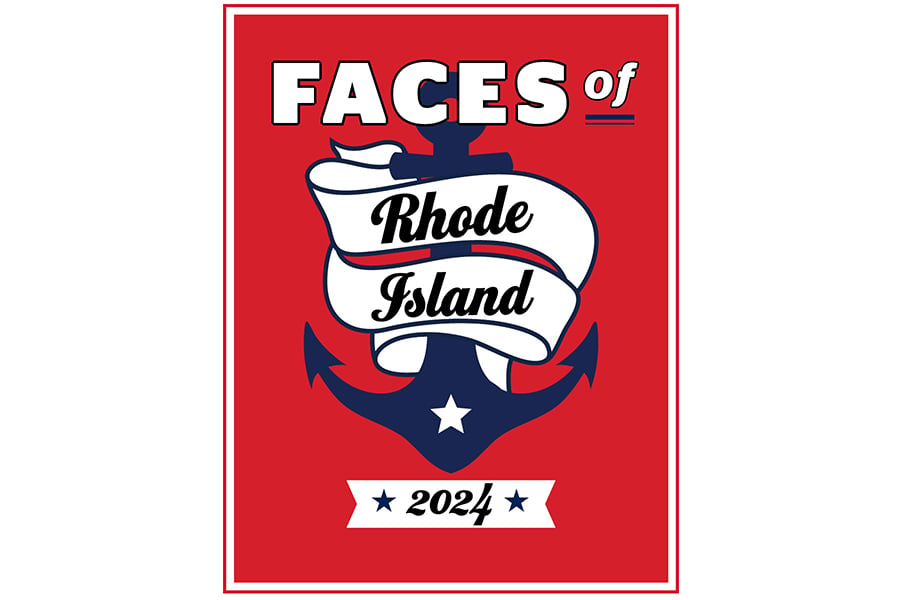Force of Nature: Checking in on the Fate of Rhode Island’s Most Endangered Species
Experts are sounding the alarm to save them before it's too late.
Measuring tape in pocket, arborist Matt Largess strides through the Fisherville Brook Wildlife Refuge. The 1,000-acre Audubon property was cleared in the nineteenth century for a farmstead as well as grist, saw and textile mills. Its namesake, Schuyler Fisher, once created the second-largest mill village in eastern Exeter, with a factory, a boardinghouse for workers and a store. But a fire claimed the mill in 1873, and eventually, the forest reclaimed the land.
On a cloudy January morning, what appears to be a mass of gray trunks sunk in lime patches of moss is a dendrological catalog of the Northeastern woods: red maple, white cedar, beech, ash, hemlocks, chestnut, tupelo, black cherry and the largest stand of Atlantic white pine in the state. For all its midwinter stillness, the forest is a place of movement and drama as it goes about its business of upheaval, renewal and life support for thousands of species. Fisherville Brook speeds under the ice scallops clinging to the stone abutments of an old dam on its way to the Pawcatuck River. Dead trees litter the floor where they are ravaged by insects, birds and bears, or annexed as shelters for small mammals. The rotting wood nourishes the soil and encourages the understory to push upward.
Largess stops before a massive white pine on a hummock above a swamp and retrieves the measuring tape.
“There it is — the Fisherville Giant — this baby. And you can tell it’s a big tree because it’s big at the bottom and it gets big at the top. So that’s a sign of great age.” He pulls the tape’s tab out to the width of the trunk at chest height.
“Twelve feet. When I started measuring this tree thirty years ago, it was ten-foot-nine. So it’s still growing, still expanding. Now it’s twelve feet in circumference, and it’s probably 120 feet tall. It’s just a great tree.”
The Fisherville Giant is a survivor of the green massacres that followed the arrival of European settlers. By 1767, nearly three-quarters of Rhode Island’s forested lands had been cleared for settlements and farms. Today agriculture occupies about 10 percent of the state’s 988,864 acres; 30 percent is developed and 56 percent are woodlands. How to keep that last percentage from dropping — or keep it growing — is one aspect of a complex and often fraught policy and ecological debate on how best to preserve the biodiversity on which our planet depends.
“When you have a big patch of something, there’s lots of little processes that are happening inside it creating microhabitats,” says David Gregg, executive director of the Rhode Island Natural History Survey. “The problem in Rhode Island is that we don’t have those big patches of forest or coastal grassland where natural processes can happen at a small scale. You’ve got residential development, which is chopping everything up into little islands of lawn separated by little whiskers of trees. That’s not going to create any of these natural microhabitats where all kinds of diversity can happen away from the impacts of people.”
More than a million species are threatened with extinction as nature declines at an accelerated and unprecedented rate, according to a report by the Intergovernmental Science-Policy Platform on Biodiversity and Ecosystem Services, an independent coalition of 130 governments. The report identifies five drivers: land and sea use changes, wildlife exploitation, climate change, pollution and invasive species.
In August, the Defenders of Wildlife applied this metric to the contiguous U.S. to determine how these factors affect biodiversity in each state. One of the biggest threats DOW identified in Rhode Island was the exploitation of wildlife — mainly pressures on fish — and the presence of invasive species. In an August webinar the organization hosted, URI College of the Environment and Life Sciences professor Laura Meyerson described how the domination of non-native phragmites in our wetlands is driving out the diamondback terrapin, which cannot penetrate the reed’s dense root structure to make its nests for reproduction.
Other tallies of local populations have shown drops in both rare and common species. In 2022, the Audubon Society of Rhode Island began sampling the avian community at its fourteen refuges looking for breeding and migration patterns, and has compiled “pretty compelling data” showing that species declining across their North American range are declining in Rhode Island more dramatically, says Charles Clarkson, the society’s director of avian research. From 2012 to 2022, the red-winged blackbird, one of North America’s most abundant birds — and a familiar sight in Rhode Island marshes — declined about 6 percent over its range, but by more than 18 percent here.
Naturalist Virginia Brown’s updated survey of thirty-four rare dragon- and damselflies of the state’s 140 species originally identified in her 2004 Odonata Atlas project has recorded the disappearance of a number of populations due to habitat loss. Climate change’s extremes — droughts and heavy rainfalls — have dried up or destroyed the aquatic environments on which they rely. The state’s largest population of ringed boghaunters — a one-and-a-half-inch long dragonfly that favors bogs and fens with acidic waters — is gone.
“It occurred in a site in Washington County, and that little wetland is no longer a wetland. It is now goldenrod and upland vegetation,” she says.
“We see the fallout of nature loss and the impacts on us in real time,” says Lindsay Rosa, DOW’s vice president of conservation research and innovation, of the impetus for the organization’s report, “Biodiversity in Crisis.” “But we don’t have a good baseline of understanding critical things like how fast are we losing biodiversity and what are the important benefits that it provides to people? Where could we be allocating our limited conservation resources to turn things around?”
Establishing the baseline is a difficult task, requiring a large team of scientists and regular funding. There is no single, ongoing source documenting every species of flora and fauna and their population trends. In 2007, budget cuts killed the Rhode Island Department of Environmental Management’s Natural Heritage Program, which identified and protected the state’s endangered species.
The Rhode Island Natural History Survey, founded in 1994, organizes an annual BioBlitz — a twenty-four-hour tally of as many plant and animal species as the volunteer teams can find on a single parcel of land. The survey is also a digital repository for other rare species census data.
Every ten years, the state Department of Environmental Management updates its State Wildlife Action Plan, identifying the species of greatest conservation need, their key habitats, threats to survival, and conservation, monitoring and management. The federal government requires the plan to be eligible for state wildlife grants. The DEM will deliver its new plan in October.
“The State Wildlife Action Plan is very broad and ambitious,” says Amanda Freitas, the Wildlife Action Plan community liaison. “Its intent is to outline all of the actions that should be taken to preserve biodiversity in the state without regard to whether we have the resources to do it or who the action-taker is.”
Protecting the environment is wildly popular with voters across the political and demographic spectrums, but there is not always consensus on what resources
should be allocated to it. For example, there have been several state bills affording forests legal protections. Last legislative session, the Old Growth Forest Protection Act died in committee. The sweeping measure would, in part, forbid logging in “old growth forests” on municipal and state lands and reestablish the Natural Heritage Program as a new state agency, which would take over the DEM’s forest management authority and duties. The bill divided forest advocates and has been opposed by the DEM. But, in 2023, the General Assembly passed solar-siting legislation that changed state development incentives to effectively halt solar development in core forests — blocks of at least 250 acres.
“We have roughly 368,000 acres of forest land in Rhode Island,” says Tee Jay Boudreau, deputy chief of RIDEM’s Division of Forest Environment. “Since 2018, there’s been approximately 1,500 acres removed for solar. That number is not gigantic, but it is still significant, and that local impact shouldn’t be minimized.”
Perhaps the biggest challenge to slowing the race to extinction is the time and coordinated effort it takes to do it. The state’s fifty-three municipal and nonprofit land trusts have preserved 62 percent of the state’s conservation lands, often through “ten-year-long relationships building trust with somebody who’s interested in conservation, and then trying to figure out how to make that work for them in perpetuity,” says Kate Sayles, executive director of the Rhode Island Land Trust Council.
In 2019, Operation Spadefoot Rhode Island rallied nine state and federal agencies, nonprofit organizations and academic institutions to rescue one of the state’s rarest amphibians. The Eastern spadefoot toad spends most of its existence burrowed into the sandy soil of open fields or wooded areas until the rumble of thunder and a violent downpour call it to the short-lived shallow ponds on the surface. In three weeks, the toads will mate, and their young will metamorphose and disperse back into the landscape to await the next perfect storm.
Since its start, the project has rescued populations and created two vernal habitat pools on South Kingstown Land Trust property. It also led to the release of toadlets raised from 1,000 tadpoles spawned after 2021’s Hurricane Henri made landfall in Westerly. No one has yet heard the sound of success — the broken-banjo-string croak of the male spadefoot — around these custom habitats.
“We knew it was going to be a long trajectory and it was going to be complicated,” says Julia Landstreet, executive director of the South Kingstown Land Trust. But this species can lie dormant for up to five years, she says. “We have a lot of hope.”
Clarkson, of the Audubon Society of Rhode Island, doesn’t dismiss the power of one.
“We live on a planet that has a finite number of resources, and we’re outstripping them faster than it is capable of producing them for our use,” he says. “And that boils down to individual action — to how you live your life.”
Or how you run your business. Caleb Grant of Maisey’s Tree Farm practices sustainable forestry — selling and custom-milling his harvests, and investing some of his profits into inclusive nature programs. His twenty-three-acre forest in Hope Valley is managed for biodiversity.
“I’m planting native species that are either underrepresented or not represented at all in the areas that I’ve cleared or areas where native species are severely compromised,” he says. “I’m trying to increase the biodiversity of the plant hosts in the plot for the upcycle effects that benefit the food chain and increase the amount of carbon stored in the forest.”
Then there’s the synergy of combining individual and collective action, as Matt Largess with his measuring tape at Fisherville Brook attests. Audubon began assembling the five properties that make up the refuge in 1988. In 2023, the DEM purchased a sixty-one-acre parcel that connected it to the Big River Management Area, creating a nearly 10,000-acre contiguous corridor of protected habitat in Exeter and West Greenwich. A professional arborist who lives in a cabin on the edge of the Pachaug State Forest, Largess uses these wild spaces as laboratories for his private research into the forest ecosystem and as outdoor classrooms to get others excited about trees.
“I do my tree walks all over and I have people that hug trees,” Largess says, pressing his body and extended arms into the crenulated bark of the Fisherville Giant to demonstrate. “You get the energy off it, you know? Some people believe that.”





























